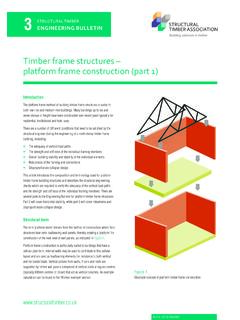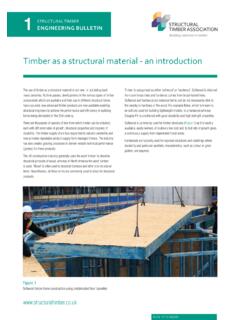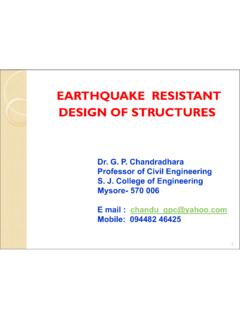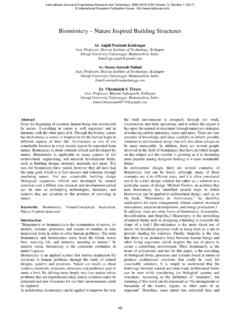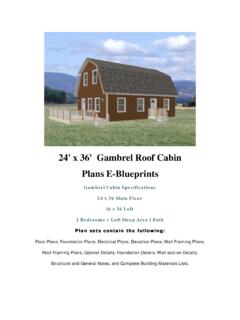Transcription of Cross-laminated timber construction - an introduction
1 IntroductionIn timber Engineering Bulletin No. 2, the engineered wood product known as Cross-laminated timber (CLT) is introduced. This article provides a more detailed introduction to the applications and use of CLT as a structural timber bulletins (Nos. 12 and 13) will provide information on the manufacture, detailing and erection of CLT and detailed advice on the structural design of CLT based on the latest knowledge and of CLT useCLT is an engineered wood panel product that was developed in Europe in the 1970s and has been in continuous development ever since, particularly in Austria and Germany. CLT is a form of large volume wood panel construction . Table 1 indicates some typical characteristics of different forms of large-volume engineered wood panel timber structures, such as CLT, are a natural choice of construction where low-embodied-carbon materials are required for where the aesthetic requirements for a dimensionally stable exposed timber finish are required.
2 CLT construction has also been used to extend the feasible height range for timber -framed building structures (Table 2 and Figure 1) and to provide shear walls in open plan timber frame is currently imported into the UK from mainland Europe but, as the UK market develops, a UK plant producing CLT from local timbers may become commercially viable. Some feasibility and research work has already been undertaken on CLT manufactured in the UK from Scottish-grown Sitka use of CLT for structural applications in North America is also rapidly expanding with the publication of a number of harmonised standards and design guides. There is currently no equivalent design guide in the UK, but TRADA is in the process of developing design and specification guidance to support the UK design of CLTCLT panels consist of not less than three cross-bonded layers of timber typically ranging in thickness between 20mm and 45mm. The timber is strength graded to BS EN 14081-1:2005 and glued together in a press, which applies pressure over the entire surface area of the panels have an odd number of layers (3, 5, 7, 9) which may be of differing thicknesses; layers are arranged symmetrically around the middle layer with adjacent layers having their grain direction at right angles to one another (Figures 2 and 3).
3 The overall thickness, as well as the loadbearing performance of the composite panel, is determined by the build-up of the individual laminates. Commonly used CLT panel thicknesses are in the range of 80 0 - timber construction - an TIMBERENGINEERING BULLETIN11 Figure 1 Span and height capabilities of mainstream structural materials in standard 0 - TIMBERENGINEERING BULLETIN112 Applications of CLTCLT is manufactured into solid wood panels which are used as walls , roofs, floors and even stairs. The building envelope can be insulated and clad with other materials such as timber , brick, render or composite timber structures of eight storeys have already been constructed in the UK. Current knowledge supports up to 12-storey designs, but the feasibility of building a timber structure up to 30 storeys tall using CLT has been investigated and a number of engineers around the world are currently investigating the use of CLT for taller structures.
4 Table 2 shows approximate span and height capabilities of the mainstream structural materials. Figure 1 shows how CLT extends the potential for timber in structures previously only possible using other configurationsCLT panels can be used for a number of different applications (Table 3). It may also be possible to use CLT panels as pre-insulated wall and roof cassettes, but care would be needed to avoid damaging the insulation in construction highlights the opportunity for prefabrication. Where a roof is required to have a simple arrangement of continuous ridges and gable ends, a room in the roof can be formed using CLT panels. A breathable roof underlay and rigid insulation will normally be located above the CLT panels to give a warm roof construction which can be prefabricated as an insulated sloping roof panels are typically supported by external walls or eaves, purlins and ridge beams. However, where resistance to horizontal forces can be provided at the eaves, a coupled roof is also possible to form clean Figure 2 CLT panel configurationFigure 3 Examples of CLT panel cross-sections and direction of grain of top layersREV 0 - TIMBERENGINEERING BULLETIN113structural ceiling lines (Figure 4).
5 The CLT panels must transfer vertical and horizontal load to the walls , purlins and ridge beams using suitably engineered mechanical constructionCLT structures are typically built using a platform frame approach, meaning that walls are temporarily braced with raking props (if possible, erection commences from a corner or braced location) before floor panels are lowered onto them and fixed. The completed floor structure provides the platform for the erection of the wall panels to the following storey. Figure 5 shows a typical multistorey construction using CLT and Figure 6 shows a typical CLT platform-frame external wall floor structures are typically arranged as one way spanning slabs, although with computer-aided analysis techniques, the two-way spanning capabilities of large slabs can be utilised. Figure 7 shows a typical floor slab arrangement using forms of CLT constructionCLT and platform-frame timber frames can be combined in a number of different ways to produce a more efficient structural external non-loadbearing walls comprising highly insulated panelsCLT floor slabs can be arranged to span parallel to external walls so that external walls can be highly insulated non-loadbearing infill panels (Figure 8).
6 This method is suitable where a regular arrangement of cross- walls can be used to provide the loadbearing structure and a high degree of thermal performance from the external walls is required. It may be necessary to consider the torsional stiffness of the frame if shear walls are arranged asymmetrically throughout the building, but CLT floor slabs can act as efficient horizontal diaphragms provided the connections between adjacent slabs are designed accordingly. CLT floor and wall components combined with other forms of constructionTimber-frame walls or concrete or masonry basements may be used to support CLT floor slabs where a thin (or exposed soffit) floor section is needed. Similarly, where there is an aesthetic requirement for exposed timber walls , CLT wall panels may by combined with either joisted or concrete floor structures. However, for low-rise construction , the increased loadbearing capacity of CLT wall panels may not add any benefit over conventional stud-framed 4 CLT roof panels formed as coupled roofFigure 6 Typical CLT platform-frame external wall-floor junctionFigure 5 Multistorey platform-frame construction using CLTREV 0 - TIMBERENGINEERING BULLETIN114 CLT used with other types of engineered timber floor structuresOther types of engineered floor joists may be combined with CLT wall panels where a lightweight floor/roof structure is more appropriate or where an exposed CLT wall panel is an aesthetic timber floor structures can be supported on top of (platform-frame approach) or inside of (balloon-frame approach) the CLT wall panels.
7 Figure 9 shows an engineered I-joist floor structure supported in a balloon-frame CLT wall panels are combined with engineered timber joists built into the wall panels (in a platform-frame approach), vertical load can be transferred through the floor zone using timber ring beams and solid timber blocking between the joists (Figure 10). In this detail the solid blocks and ring beam should be an engineered timber product such as laminated veneer lumber (LVL) or laminated strand lumber (LSL) in order to minimise shrinkage across the floor an alternative to using engineered timber within the platform frame floor zones, top-chord supported open web joists can be used to avoid the requirements for solid blocking beneath walls (Figure 11).Reference should be made to TRADA Guidance Document 10 (GD10)5 for a comparison of the relative stiffness and self-weights of various engineered timber floor timber /concrete floorsCLT floor slabs can also be used to form wood/concrete composite floors, where the CLT slab is used as a permanent formwork with horizontal shear transfer between materials being provided by shear plates and walls have also been used to support precast concrete floors where it is considered that the increased thermal mass of a concrete floor would be supported by glulam/steel framesAs an alternative to forms of construction using loadbearing walls , CLT floor slabs can also be supported on a frame of glulam or steel downstand beams and columns in order to create large open-plan areas.
8 This method can also be used where loadbearing CLT walls are not possible or would add unnecessary weight (Figures 12 and 13).Table 1: Characteristics of large-volume engineered wood panel productsTable 2: Approximate span and height capabilities of mainstream structural materialsREV 0 - TIMBERENGINEERING BULLETIN115 Hybrid CLT productsSome hybrid CLT products are also available, including Leno Plus (MERK), which is a Cross-laminated panel product containing a central layer of 32mm LVL. Due to the layer of LVL, there are no joints in the to construction process of using CLTU sing CLT for prefabricated wall and floor panels offers many advantages: the cross-laminating process provides improved dimensional stability compared to sawn timber , which allows for prefabrication of long, wide floor slabs, long single-storey walls and tall wall panels CLT, like other structural wood-based products, lends itself well to prefabrication, resulting in very rapid construction , reliable on-site programming and ease of dismantling at the end if its service life CLT panels are inherently robust during transport and construction , resulting in fewer defects CLT structures require fewer onsite mechanical fixings where large prefabricated panel elements are adopted CLT structures require no wet trades and are assembled with lightweight power tools, although cranes are needed to lift the panels into place fixing cladding materials, services and fittings to CLT walls is easier to achieve with woodscrews than with, for example, concrete and masonry walls .
9 Items can be fixed directly to the CLT panels the relatively low level of noise and disruption on a CLT site may offer advantages on infill sites where the impact on neighbours is an important consideration the added benefit of being made from a renewable resource makes all wood-based systems desirable from a sustainability point of view. CLT buildings have a very low carbon footprint because the wood material locks away the carbon absorbed during growth. This can result in carbon-negative benefits of CLTThe structural benefits of CLT over conventional softwood wall framing and joisted floor constructions include its large axial and flexural loadbearing capacity when used as a wall or slab, its high inplane shear strength when used as a shear wall, its fire resistance characteristics for exposed applications and its superior acoustic to its arrangement as a solid wall panel, rather than a framed construction comprising discrete loadbearing post elements, CLT also distributes concentrated loads as line loads at foundation level, which will reduce the requirement for localised pad 8 Hybrid options for combining highly insulated external walls with CLT loadbearing cross-wallsFigure 7 Typical floor slab arrangement using CLT showing continuity over internal loadbearing walls but discontinuity over separating 3.
10 Applications of CLTREV 0 - TIMBERENGINEERING BULLETIN116 Figure 10 Wall-joist detail platform-frame methodFigure 9 Wall-joist detail balloon-frame methodThe reinforcement effect provided by the cross-laminations in CLT also considerably increases the splitting resistance of CLT for certain types of dowel-type fasteners. Problematic end-grain connections are also avoided since there is always a layer of cross-grain to fix will generally find that working stresses are low due to the large cross-sections. The structural benefits of CLT construction when compared to traditional platform timberframe construction are that: CLT walls have high axial load capacity due to the bearing area of loadbearing elements CLT walls have high in-plane shear strength walls to resist horizontal loads CLT structures can have significant deadweight to resist overturning forces, resulting in less need for mechanical holding-down resistance to be provided CLT wall panels have inherent fire resistance due to their large section size compared to timber -frame walls comprising discrete studs.

